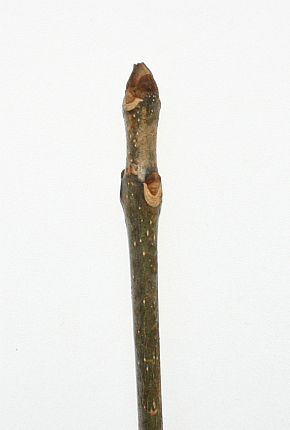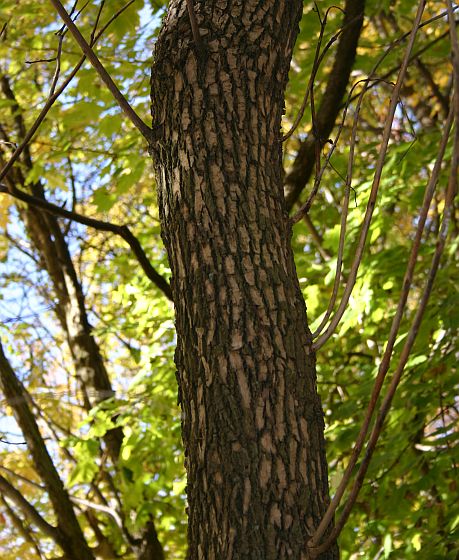
Here’s a tree that will soon disappear from western Pennsylvania, a victim of the emerald ash borers that arrived here in 2007.
White ash (Fraxinus americana) is easily identified by its twig with the chocolate-brown bud. The twig is stout, the leaf buds are opposite each other, the leaf scar is a horseshoe shape under each leaf bud, and all the buds are chocolate brown. (Click here for definitions of twig anatomy.)
It’s easy to find these buds in our area. There are many white ash seedlings now because the trees have put out a lot of seed while they’re under attack.
Opposite leaf buds are a good marker for the ash because most trees have alternate leaves. The main species with opposites are maples, ashes, buckeyes and dogwoods. I learned to remember opposite leaves with the acronym MAB DOG (Maple, Ash, Buckeye and Dogwood).
White ash bark is distinctive too. Its deeply ridged and the ridges join to form long diamond shapes as shown below.

.
Unfortunately, larvae of the emerald ash borer kill the tree by tunneling under the bark and damaging the phloem and xylum. Often this causes the ridges to slowly separate from the bark. Woodpeckers hear the larvae (amazing!) and chip away at the ridges to get at the bugs. The result is that a dying tree has pale patches where the ridges fell off. Infected trees try to survive by sending out sprouts near the ground. You can see both effects on the trunk below.

.
If you examine the chipped bark closely you may find the D-shaped exit hole of the emerald ash borer. (Thanks to Dianne Machesney for this photo.).

.
Learn the white ash now. Sadly, it won’t be with us much longer.
(photos by Kate St. John, except for the one noted by Dianne Machesney)
Great tutorial on the ash, Kate! I used to have a tree book, and I liked it a lot, but I never got into it as much as I would have liked. I’m going to enjoy this series a lot
Rob
Turning an Ash leaf over, will show you why it’s called “White”. It’s because of bottom side on leaf is white, not light green. Till you see one, you will look at many green ash tree leaves and wonder if it is a White, because of light green compared to top side. Once you find a White Ash leaf, you will remember forever, because it is so white, no question about it. Then look up into tree, you will see all white bottom half of leaves facing you.
I still don,t have the bark down yet for green vs white ash. Been fooled till spring when leaves come out. Can’t wait to use chocolate bud part to identify. Unfortunately, another way of identifying white is to look at growth rings when tree is cut down. Green ash has many fat years, White ash rings are very uniform, every year. It’s a “slow growth tree”. I think when the White has a good growing year, it does not take advantage of it by limiting it’s growth. Bad year rings are same size as good too. Tree really paces itself, rings look so uniformly cool, you know its got to be the white.
People are also fooled by age of ash trees, say compared to an Elm trunk, which is so big at 100. It’s a shame when a small slow growth white ash is not saved because they think tree is not that old! Pumpkin ash(natural cross between white & green) grows quickly in swamps, so age rings like cottonwood(has fat buttressed bottom trunk, to hold roots in wet swamp dirt. Walk up to stump and swear tree must have been 200 yrs old, but when counted, it’s only 88. Chicago treated our parkway ash and tree-age injections working 100%, while untreated Ash right next to it, is dead and long gone already. So cool looking at treated tree and knowing that it should be dried up and dead, but so bushy and alive.
Green can live over 300 yrs, White, over 6OO years! Once all untreated ash in area killed by EAB, no more food for bug, since only eats ash. They can not live off of twig sprouts, and ash does not have bush type like Elm, and it’s DED that hangs around. USA is on second, more virulent strain of mold spores, the last 10 yrs. Elm beetle carries mold on it’s back to grow stuff on new Elm. I guess they feed on it.
Wonderful site. Now that I am into native trees, I want to know the birds I hear, and sometimes see, like an Oreo yesterday. What a song/call. Squirrels love nesting in ash, maybe because of thick branches that are opposite to each other. sicadias like ash too. Were going to loose a lot of 17 year ones because of EAB. It’s every 17 years i figured because our moon cycles every 18 years, cool huh. Bird watchers got to love the numerous new woodpecker chicks because of EAB bugs good feeding.